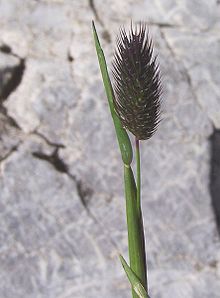
Timothy is an abundant perennial grass native to most of Europe except for the Mediterranean region. It is also known as timothy-grass, meadow cat's-tail or common cat's tail. It is a member of the genus Phleum, consisting of about 15 species of annual and perennial grasses.

Alopecurus pratensis, known as the meadow foxtail or the field meadow foxtail, is a perennial grass belonging to the grass family (Poaceae). It is native to Europe and Asia.
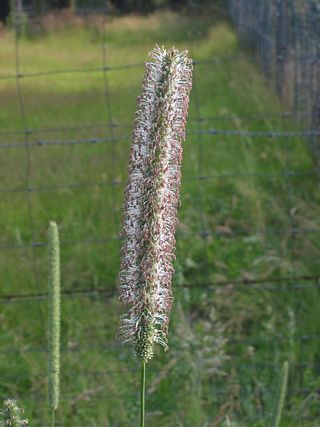
Phleum (timothy) is a genus of annual and perennial plants in the grass family. The genus is native to Europe, Asia and north Africa, with one species also in North and South America.

Hainardia is a genus of coastal plants in the grass family, native to the Mediterranean Basin.

Alopecurus aequalis is a common species of grass known as shortawn foxtail or orange foxtail. It is native to much of the temperate Northern Hemisphere from Eurasia to North America. It is most commonly found in areas near fresh water, such as the margins of ponds and ditches.

Briza minor is a species of grass known by the common names lesser quaking-grass or little quakinggrass. It is native to the Mediterranean Basin, and it is known elsewhere, including much of North America, as an introduced species. It is an annual grass producing narrow clumps of erect stems up to 50 centimeters tall. The inflorescence bears several small cone-shaped spikelets, each hanging on a pedicel.
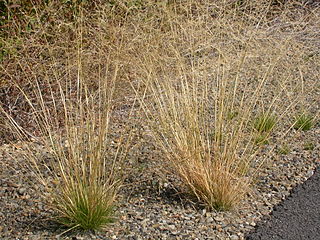
Agrostis scabra is a common species of grass known by the common names hair grass, rough bent, rough bent grass, winter bent grass, and ticklegrass. A tumbleweed, it is a bunchgrass native to Asia and much of North America, and widely known elsewhere as an introduced species.

Chloris virgata is a species of grass known by the common names feather fingergrassfeathery Rhodes-grass and feather windmill grass.

Cynosurus echinatus is a species of grass known by the common names bristly dogstail grass, rough dog's-tail and hedgehog dogtail. It is native to southern Europe, and it is known in the Americas and Australia as an introduced species and sometimes a noxious weed. An herbicide-resistant strain can be found growing as a weed in canola and wheat fields in Chile. This is an annual grass growing 10 to 50 centimeters tall. The inflorescence is a rounded or oval cluster or series of clusters of spikelets. The fertile spikelet has an awn up to a centimeter long. The awns clumped closely together into a tuft gives the inflorescence its bristly, hairy appearance.

Minuartia stricta is a species of flowering plant in the family Caryophyllaceae known by the common names bog stitchwort, Teesdale sandwort and rock sandwort. It has a circumboreal distribution, occurring throughout much of the northernmost Northern Hemisphere from the lower Arctic into the alpine climates of mountainous areas in temperate Eurasia and North America. It grows in several types of habitat, including meadows, marshes, heath, beaches and bars, and arctic and alpine tundra.

Paspalum distichum is a species of grass. Common names include knotgrass, water finger-grass, couch paspalum, eternity grass, gingergrass, and Thompson grass. Its native range is obscure because it has long been present on most continents, and in most areas it is certainly an introduced species. Its native range probably includes parts of the tropical Americas.

Poa glauca is a species of grass known by the common names glaucous bluegrass, glaucous meadow-grass and white bluegrass. It has a circumboreal distribution, occurring throughout the northern regions of the Northern Hemisphere. It is also known from Patagonia. It is a common grass, occurring in Arctic and alpine climates and other areas. It can be found throughout the Canadian Arctic Archipelago in many types of habitat, including disturbed and barren areas.

Schismus barbatus is a species of grass known as common Mediterranean grass and kelch-grass. It is native to Eurasia, and it is also known as an introduced species in the southwestern United States. It grows in many habitats, including disturbed areas. It is an annual grass growing in small clumps. The stems grow up to 27 centimeters long and are lined with threadlike leaves. The short inflorescence bears spikelets under a centimeter long.

Setaria verticillata is a species of grass known by the common names hooked bristlegrass, rough bristle-grass and bristly foxtail. It is native to Europe, but it is known on most continents as an introduced species and often a noxious weed. It is a hardy bunchgrass which grows in many types of urban, cultivated, and disturbed habitat. It is a weed of many types of agricultural crops, growing in vineyards and fields. Herbicide-resistant strains have been noted.

Sisyrinchium californicum is a species of flowering plant in the iris family known by the common names golden blue-eyed grass, yellow-eyed-grass, and golden-eyed-grass. It is native to the west coast of North America from British Columbia to central California, where it grows in moist habitat, often in coastal areas.

Thalictrum alpinum is a species of flowering plant in the buttercup family known by the common names alpine meadow-rue and arctic meadow-rue. It is native to Arctic and alpine regions of North America and Eurasia, including Alaska, northern Canada, and Greenland, and it occurs in cold, wet, boggy habitats in high mountains farther south.
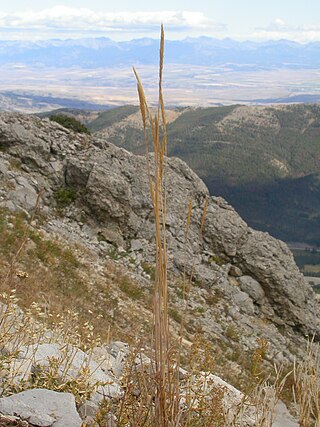
Trisetum spicatum is a species of grass known by the common name spike trisetum and spike false oat. It is native to North America, Eurasia, and South America. In North America it occurs throughout northern regions, including northern sections of the United States and most all of Canada, its range continuing to Greenland. It is widespread throughout the Canadian Arctic Islands. The grass occurs in a variety of Arctic and alpine habitat types, as well as many types of mountainous habitat in regions farther south. It is a perennial grass forming clumps of erect stems ranging in height from just a few centimeters to over one meter. The narrow leaves are mostly located around the bases of the densely clumped stems. The inflorescence is a narrow spike a few centimeters long or up to 30 to 50 centimeters in maximum length. The spikes are green to purple or brownish and shiny.
Achnatherum richardsonii is a species of grass known by the common names Richardson's needlegrass, spreading needlegrass, and Canada mountain-ricegrass. It is native to northwestern North America, where it is distributed from Alaska and Yukon through the western Canadian provinces south to Colorado.

Carex bigelowii is a species of sedge known by the common names Bigelow's sedge, Gwanmo sedge, and stiff sedge. It has an Arctic–alpine distribution in Eurasia and North America, and grows up to 50 centimetres (20 in) tall in a variety of habitats.
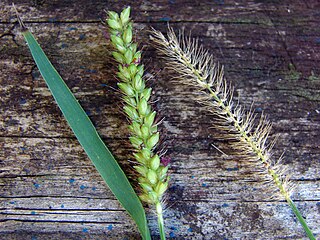
Setaria parviflora is a species of grass known by the common names marsh bristlegrass, knotroot bristle-grass, bristly foxtail and yellow bristlegrass. It is native to North America, including Mexico and the United States from California to the East Coast, Central America and the West Indies, and South America.
